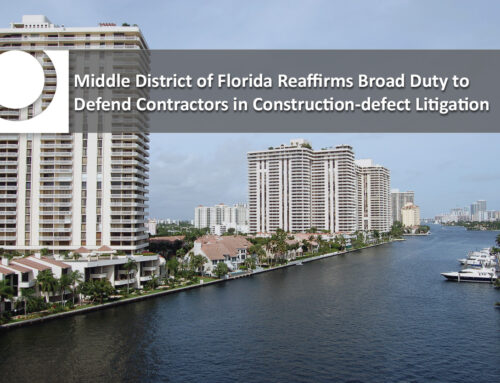Rather than litigating the amount of coverage, an insured may — and often does — settle the claim. The insured may do this for a variety of reasons, including wanting to avoid the time and expense of protracted litigation, avoiding the burden and disruption of discovery during that litigation, or the real and unfortunate need to have cash in his or her pocket to make needed repairs. But as a recent case from U.S. District Court for the District of New Jersey illustrates, an insured should carefully review the insurer’s proposed settlement agreement to ensure that he or she is releasing the insurer only from liability for the claim submitted.
In Giaccone v. Canopius U.S. Ins. Co., (D. N. J. June 29, 2015), the insureds submitted a claim to their insurer for property damages caused by Hurricane Sandy on October 29, 2012. After an inspection, the insurer’s claims agent represented to the insureds that 80% of the damages sustained to the property were a result of a subsequent storm, rather than Hurricane Sandy. The insurer then made a settlement offer to the insureds, indicating that the offer would have been less if it was limited solely to damage caused by Hurricane Sandy.
 On November 27, 2013, the parties executed a settlement agreement, which provided for full settlement of the outstanding insurance claim. But the agreement also provided that, in addition to releasing the insurer from the claim, the insurer was also released from any and all claims which the insureds may have had against the insurer under the policy, and the insureds further agreed that they had no remaining claims of any kind under the policy. The insureds were apparently not represented by an attorney.
On November 27, 2013, the parties executed a settlement agreement, which provided for full settlement of the outstanding insurance claim. But the agreement also provided that, in addition to releasing the insurer from the claim, the insurer was also released from any and all claims which the insureds may have had against the insurer under the policy, and the insureds further agreed that they had no remaining claims of any kind under the policy. The insureds were apparently not represented by an attorney.
On January 16, 2014, the insureds submitted an additional claim under the policy for property damages sustained on January 31, 2013 because of a subsequent storm. Five months later, the insurer denied coverage on the ground that the settlement agreement released the insurer from any and all obligations under the policy. The insureds brought suit against the insurer for breach of contract and breach of the duty of good faith and fair dealing.
The U.S. District Court for the District of New Jersey granted the insurer’s motion for summary judgment, making short work of the insureds’ arguments that the terms of the settlement agreement did not provide for a release of the insurer’s liability for the subsequent claim and, alternatively, that the insureds never agreed to the complete release of all claims.
The court first found that the settlement agreement “could not be clearer in its broad expression of the scope of the released claims” and “it is a bedrock principle of contract interpretation that the phrase ‘any and all’ allows for no exceptions.” The relevant provisions therefore “make plain that the settlement agreement subsumed and covered all of the damages to [the insureds’] property up to the November 27, 2013 settlement date.” Accordingly, the court found that the settlement agreement released the insurer for liability for the claim submitted on January 16, 2014, in addition to the Hurricane Sandy claim that the insureds thought was all they were releasing.
The insurers also argued that they were not aware that they were waiving any rights beyond those related to the Hurricane Sandy claim, and that the release was ineffective as to the January 16, 2014 claim. The insureds pointed to the facts that their public adjuster, as well as the insurer’s claims’ administrator, communicated that the settlement agreement related only to the Hurricane Sandy claim. The court, however, disregarded these facts, faulted the insureds for failing to read the agreement carefully, and refused to rescind any portion of the settlement agreement.
The lessons here are clear. It is common sense for an insured to assume that in settling a claim with his or her insured, the settlement agreement would call for a resolution of that claim only. As Giaccone painfully illustrates, however, an insurer will often attempt to reach beyond that and absolve itself of any further liability under the policy at issue — asking for what is commonly known as a “policy release” that applies to destroy any coverage under the policy, no matter what may be left in limits or other coverages.
Where a settlement agreement is offered by the insurer, the insured must carefully review the agreement to ensure that it is releasing only its submitted claim. An experienced coverage attorney can assist and explain the extent of any release contained in the proposed agreement. Otherwise, absent evidence of a fraud or misrepresentation by the insurer to induce the insured to sign, a court will likely hold the insured to the agreement, regardless of whether the insured understood its full implications.



